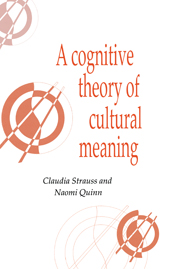3 - Schema theory and connectionism
Published online by Cambridge University Press: 05 June 2012
Summary
We have said that meanings are based on cultural schemas, schemas that have come to be shared among people who have had similar socially mediated experiences. What are schemas?
To illustrate what schemas are and how they work, imagine two television commercials for different brands of beer. In one, the scene is a party filled with attractive and well-mannered men and women in their late twenties or early thirties. The other ad features potbellied lumberjacks joking loudly. You, the viewer, immediately make some assumptions about these people. You might assume that the first group of people are middle-to-upper-middle class, probably college educated, while the second are probably not college educated. Based on these assumptions, you have some guesses about the kinds of beer they are touting: a somewhat more expensive brand in the first commercial than in the second. The very words we used to describe these commercials probably led you to some further assumptions. You no doubt assumed that the lumberjacks were men. You may even have a picture of what clothing they were wearing (flannel shirts and pants held up with suspenders). Even if you did not arrive at these particular assumptions, surely you had some interpretations – some meanings – that were not contained in the information we gave you.
On what basis did you arrive at your interpretations? The description we gave elicited your schemas for lumberjacks, for class differences, for beers or for consumer items, generally, and for television commercials.
Information
- Type
- Chapter
- Information
- A Cognitive Theory of Cultural Meaning , pp. 48 - 84Publisher: Cambridge University PressPrint publication year: 1998
Accessibility standard: Unknown
Why this information is here
This section outlines the accessibility features of this content - including support for screen readers, full keyboard navigation and high-contrast display options. This may not be relevant for you.Accessibility Information
- 1
- Cited by
